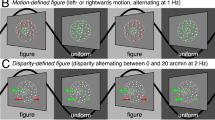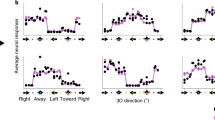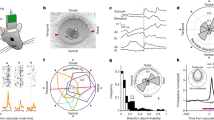Abstract
Motion and stereoscopic depth are fundamental parameters of the structural analysis of visual scenes. Because they are defined by a difference in object position, either over time or across the eyes, a common neural machinery may be used for encoding these attributes. To examine this idea, we analyzed responses of binocular complex cells in the cat striate cortex to stimuli of various intra- and interocular spatial and temporal shifts. We found that most neurons exhibit space–time-oriented response profiles in both monocular and binocular domains. This indicates that these neurons encode motion and depth jointly, and it explains phenomena such as the Pulfrich effect. We also found that the relationship between neuronal tuning of motion and depth conforms to that predicted by the use of motion parallax as a depth cue. These results demonstrate a joint-encoding of motion and depth at an early cortical stage.
This is a preview of subscription content, access via your institution
Access options
Subscribe to this journal
Receive 12 print issues and online access
$209.00 per year
only $17.42 per issue
Buy this article
- Purchase on Springer Link
- Instant access to full article PDF
Prices may be subject to local taxes which are calculated during checkout






Similar content being viewed by others
References
Braddick, O. A short-range process in apparent motion. Vision Res. 14, 519–527 (1974).
Wheatstone, C. Contributions to the physiology of vision: I. On some remarkable and hitherto unobserved phenomena of binocular vision. Phil. Trans. Royal Soc. Lond. 128, 371–394 (1838).
Pulfrich, C. Die Stereoskopie im Dienste der isochromem und herterochromen Photometrie. Naturwissenschaft 10, 553–564 (1922).
Julesz, B. & White, B. Short term visual memory and the Pulfrich phenomenon. Nature 222, 639–641 (1969).
Morgan, M. J. & Thompson, P. Apparent motion and the Pulfrich effect. Perception 4, 3–18 (1975).
Burr, D. C. & Ross, J. How does binocular delay give information about depth? Vision Res. 19, 523–532 (1979).
Cynader, M., Gardner, J. & Douglas, R. in Frontiers in Visual Science (Cool, S. J. & Smith, E. L., eds.) 373–386 (Springer, Berlin, 1978).
Carney, T., Paradiso, M. A. & Freeman, R. D. A physiological correlate of the Pulfrich effect in cortical neurons of the cat. Vision Res. 29, 155–165 (1989).
Lit, A. The magnitude of the Pulfrich stereophenomenon as a function of binocular differences in intensity at various levels of illumination. Am. J. Psych. 62, 159–181 (1949).
Wilson, J. A. & Anstis, S. M. Visual delay as a function of luminance. Am. J. Psych. 82, 350–358 (1969).
Nickalls, R. W. The rotating Pulfrich effect, and a new method of determining visual latency differences. Vision Res. 26, 367–372 (1986).
Howard, I. P. & Rogers, B. J. Binocular Vision and Stereopsis (Oxford Univ. Press, New York, 1995).
Tyler, C. W. Stereopsis in dynamic visual noise. Nature 250, 781–782 (1974).
Falk, D. S. Dynamic visual noise and the stereophenomenon: interocular time delays, depth and coherent velocities. Percept. Psychophys. 28, 19–27 (1980).
Lee, D. N. A stroboscopic stereophenomenon. Vision Res. 10, 587–593 (1970).
Morgan, M. J. Perception of continuity in stroboscopic motion: a temporal frequency analysis. Vision Res. 19, 491–500 (1979).
Ross, J. Stereopsis by binocular delay. Nature 248, 363–364 (1974).
Qian, N. & Andersen, R. A. A physiological model for motion-stereo integration and a unified explanation of Pulfrich-like phenomena. Vision Res. 37, 1683–1698 (1997).
Sutter, E. E. in Nonlinear Vision: Determination of Neural Receptive Fields (Pinter, R. B. & Nabet, B., eds.) 171–220 (CRC, Boca Raton, 1992).
Anzai, A., Ohzawa, I. & Freeman, R. D. Neural mechanisms for processing binocular information I. Simple cells. J. Neurophysiol. 82, 891–908 (1999).
Anzai, A., Ohzawa, I. & Freeman, R. D. Neural mechanisms for processing binocular information II. Complex cells. J. Neurophysiol. 82, 909–924 (1999).
Emerson, R. C., Citron, M. C., Vaughn, W. J. & Klein, S. A. Nonlinear directionally selective subunits in complex cells of cat striate cortex. J. Neurophysiol. 58, 33–65 (1987).
DeAngelis, G. C., Ohzawa, I. & Freeman, R. D. Spatiotemporal organization of simple-cell receptive fields in the cat's striate cortex. I. General characteristics and postnatal development. J. Neurophysiol. 69, 1091–1117 (1993).
DeAngelis, G. C., Ghose, G. M., Ohzawa, I. & Freeman, R. D. Functional micro-organization of primary visual cortex: receptive field analysis of nearby neurons. J. Neurosci. 19, 4046–4064 (1999).
O. Braddick, A. Adlard in Visual Psychophysics and Physiology (Armington, J. C., Krauskopf, J. & Wooten, B. R., eds.) 417–426 (Academic, New York, 1978).
Georgeson, M. A. & Shackleton, T. M. Monocular motion sensing, binocular motion perception. Vision Res. 29, 1511–1523 (1989).
Carney, T. & Shadlen, M. N. Dichoptic activation of the early motion system. Vision Res. 33, 1977–1995 (1993).
Carney, T. & Shadlen, M. N. Binocularity of early motion mechanisms: comments on Georgeson and Shackleton. Vision Res. 32, 187–191 (1992).
Georgeson, M. A. & Shackleton, T. M. No evidence for dichoptic motion sensing: a reply to Carney and Shadlen. Vision Res. 32, 193–198 (1992).
Morgan, M. J. & Castet, E. Stereoscopic depth perception at high velocities. Nature 378, 380–383 (1995).
Ziegler, L. R. & Roy, J.-P. Large scale stereopsis and optic flow: depth enhanced by speed and opponent-motion. Vision Res. 38, 1199–1209 (1998).
Adelson, E. H. & Bergen, J. R. Spatio-temporal energy models for the perception of motion. J. Opt. Soc. Am. A2, 284–299 (1985).
Emerson, R. C., Bergen, J. R. & Adelson, R. H. Directionally selective complex cells and the computation of motion energy in cat visual cortex. Vision Res. 32, 203–218 (1992).
Ohzawa, I., DeAngelis, G. C. & Freeman, R. D. Stereoscopic depth discrimination in the visual cortex: neurons ideally suited as disparity detectors. Science 249, 1037–1041 (1990).
Ohzawa, I., DeAngelis, G. C. & Freeman, R. D. Encoding of binocular disparity by complex cells in the cat's visual cortex. J. Neurophysiol. 77, 2879–2909 (1997).
Movshon, J. A., Thompson, I. D. & Tolhurst, D. J. Receptive field organization of complex cells in the cat's striate cortex. J. Physiol. (Lond.) 283, 79–99 (1978).
Szulborski, R. G. & Palmer, L. A. The two-dimensional spatial structure of nonlinear subunits in the receptive fields of complex cells. Vision Res. 30, 249–254 (1990).
Gaska, J. P., Jacobson, L. D., Chen, H. W. & Pollen, D. A. Space-time spectra of complex cell filters in the macaque monkey: a comparison of results obtained with pseudowhite noise and grating stimuli. Vis. Neurosci. 11, 805–821 (1994).
Ohzawa, I. & Freeman, R. D. The binocular organization of complex cells in the cat's visual cortex. J. Neurophysiol. 56, 243–259 (1986).
Rogers, B. J. & Graham, M. E. Motion parallax as an independent cue for depth perception. Perception 8, 125–134 (1979).
Poggio, G. F. & Fischer, B. Binocular interaction and depth sensitivity in striate and prestriate cortex of behaving rhesus monkey. J. Neurophysiol. 40, 1392–1405 (1977).
Maunsell, J. H. & Van Essen, D. C. Functional properties of neurons in middle temporal visual area of the macaque monkey. II. Binocular interactions and sensitivity to binocular disparity. J. Neurophysiol. 49, 1148–1167 (1983).
Felleman, D. J. & Van Essen, D. C. Receptive field properties of neurons in area V3 of macaque monkey extrastriate cortex. J. Neurophysiol. 57, 889–920 (1987).
Roy, J.-P., Komatsu, H. & Wurtz, R. H. Disparity sensitivity of neurons in monkey extrastriate area MST. J. Neurosci. 12, 2478–2492 (1992).
Bradley, D. C., Qian, N. & Andersen, R. A. Integration of motion and stereopsis in middle temporal cortical area of macaques. Nature 373, 609–611 (1995).
DeAngelis, G. C., Cumming, B. G. & Newsome, W. T. Cortical area MT and the perception of stereoscopic depth. Nature 394, 677–680 (1998).
Press, W. H., Teukolsky, S. A., Vetterling, W. T. & Flannery, B. P. Neumerical Recipes in C 2nd edn. (Cambridge Univ. Press, New York, 1992).
Acknowledgements
We thank G. DeAngelis for helpful comments and suggestions. This work was supported by research and CORE grants from the National Eye Institute (EY-01175 and EY-03176).
Author information
Authors and Affiliations
Corresponding author
Rights and permissions
About this article
Cite this article
Anzai, A., Ohzawa, I. & Freeman, R. Joint-encoding of motion and depth by visual cortical neurons: neural basis of the Pulfrich effect. Nat Neurosci 4, 513–518 (2001). https://doi.org/10.1038/87462
Received:
Accepted:
Issue Date:
DOI: https://doi.org/10.1038/87462
This article is cited by
-
Interocular contrast difference drives illusory 3D percept
Scientific Reports (2017)
-
The investigation of acute optic neuritis: a review and proposed protocol
Nature Reviews Neurology (2014)
-
Distance modulated neuronal activity in the cortical visual areas of cats
Experimental Brain Research (2011)
-
The Pulfrich effect in the clinic
Graefe's Archive for Clinical and Experimental Ophthalmology (2011)
-
Integrating motion and depth via parallel pathways
Nature Neuroscience (2008)



